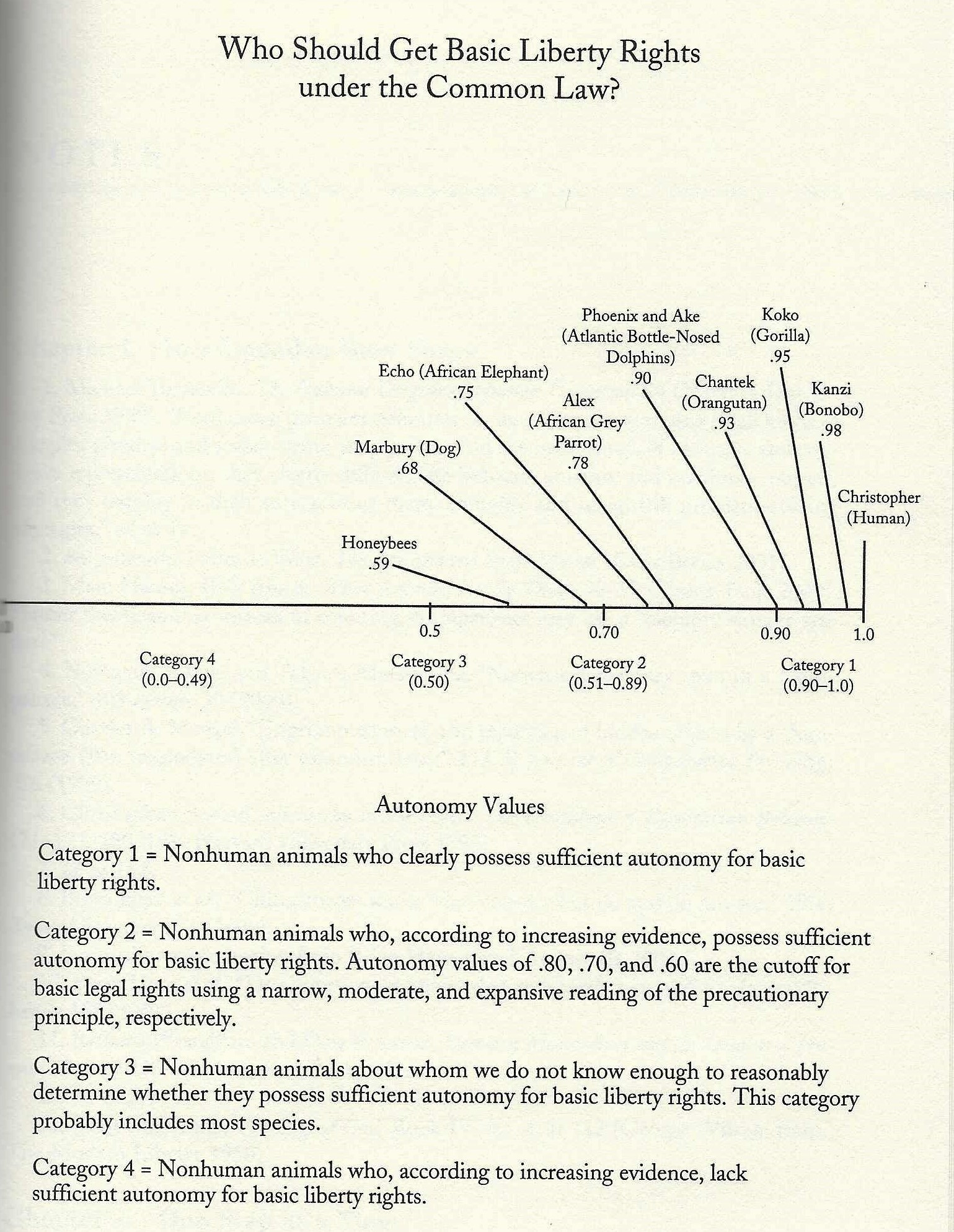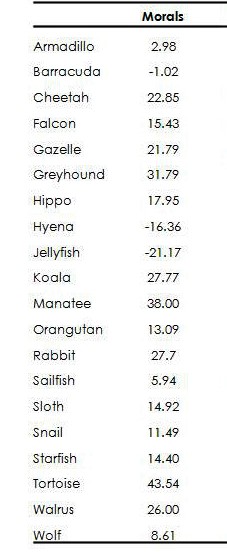Comparing Species: Measures of Autonomy, Intelligence, and Morality of Non-human Species
Approach 1: A Scale of Practical Autonomy
In his book Drawing the Line: Science and the Case for Animal Rights (2002), Steven Wise argues that “autonomy values” can be assigned to species and provide an appropriate basis for determining which animals are entitled to “basic liberty rights.” The higher its autonomy value, the more clearly the specie is deserving of liberty rights.
Wise draws on the work of Donald Griffin, who suggested that our degree of certainty that a particular specie has autonomy (that is, “feels or wants or acts intentionally or knows it has a self”) can be expressed on a scale running from 1.0 to 0.0, with 1.0 meaning that there is a 100% chance a specie has autonomy and 0.0 meaning that there is a 0% chance a specie has autonomy. Humans, on this scale, would obviously be assigned an autonomy value of 1.0. Given our close evolutionary relationship and a range of similar behaviors, chimpanzees should also have a high autonomy value. Wise assigns them an autonomy value of .98. He suggests that any specie that passes the mirror recognition test (that is, knows that the image he or she sees in a mirror is himself or herself) should have an autonomy value of at least .90. Using this general approach, Wise comes up with the following chart:

Approach 2: Counting Cortical Neurons
Scott Alexander, in a March 25, 2019 post on Slate Star Codex, titled “NEURONS AND INTELLIGENCE: A BIRDBRAINED PERSPECTIVE” suggested that a good rough measure of the relative intelligence of different animal species is to compare the number of cortical neurons a member of each species has on average.
Counting cortical neurons seems to produce better results than alternative measures. For example, simply comparing brain sizes would suggest that elephants, with their much bigger brains, should be smarter than humans. Another idea, comparing brain size relative to body size would predict that the smartest animal in the world should be a shrew. A slightly more sophisticated measure is to look at a statistic called “encephalization quotient” (EQ), which compares an animal’s brain size to its predicted brain size given an equation that fits most animals. But this measure, too, has problems. It would suggest that capuchin monkeys are smarter than chimps (capuchins have a higher EQ). Also, several bird species have lower encephalization quotients than small mammals, but the evidence strongly suggests they are more intelligent.
Alexander notes that a new AI Impacts report on animal intelligence, partly based on research by Suzana Herculano-Houzel, builds on the hypothesis that “if we knew what made some animals smarter than others, it might help us figure out what intelligence is in a physiological sense, and that might help us predict the growth of intelligence in future AIs.” The report analyzes bird brains and concludes that their surprising intelligence, given their small brain size, is likely because birds, unlike mammals which have “a neocortex arranged in a characteristic pattern of layers, have a different unlayered structure called the pallium with neurons ‘organized into nuclei’.” Put in another way, birds have lots of cortical neurons.
So Alexander argues that “the number of cortical neurons may be one of the most important biological substrates of intelligence.” Elephants have big brains, but the neurons in their brain are also very big. So, it seems, it is the number of cortical neurons, not the size of the brain matters more.
Comparing species, we find that elephants have about 7,000 neurons per mg of brain tissue. Humans have about 25,000. Birds have up to 200,000. A small crow has roughly the same number of neurons as a large monkey. Counting cortical neurons reveals that humans have 16 billion and elephants only5.6 billion. Alexander concludes, “A list of animals by cortical neuron count really beautifully matches our intuitive perceptions of which animals are more intelligent, whether we’re talking about primates or birds or whatever. All else being equal, people with larger brain volumes tend to be smarter than people with smaller brains, suggesting that the neuron number/intelligence relationship holds true for us too.”
But every measure, even counting cortical neurons (which seems the best) produces some questionable result with respect to some specie or another. For cortical neuron counters, the problem is pilot whales, which have about 37 billion cortical neurons, which is twice as many as humans. So are pilot whales really twice as smart as humans and we just don’t know that?
This might remind you of Douglas Adams in So Long, and Thanks for All the Fish:
“On the planet Earth, man had always assumed that he was more intelligent than dolphins because he had achieved so much—the wheel, New York, wars and so on—whilst all the dolphins had ever done was muck about in the water having a good time. But conversely, the dolphins had always believed that they were far more intelligent than man—for precisely the same reasons.”
The following is a list of species and the number of cortical neurons for each:
Animal Number of cortical neurons Number of cortical neurons compared to humans (%)
Lobster 100,000 0.0006
Chicken 50 million 0.3
Cow 300 million 1.9
Pig 425 million 2.7
Giraffe 1.6 billion 10
Elephant 5.6 billion 35
Chimpanzee 6.2 billion 39
Human 16 billion 100
Approach 3: Wild Guesses of Morality
Leif Nelson, in a November 25, 2013 post, described a rather frivolous experiment he conducted:
"In surveys, most people answer most questions. That is true regardless of whether or not questions are coherently constructed and reasonably articulated. That means that absurd questions still receive answers, and in part because humans are similar to one another, those answers can even look peculiarly consistent. I asked an absurd question and was rewarded with an entertaining answer. Some years ago, with Tom Meyvis, I tried to develop a manipulation to create an association between speed and virtue. Our spartan publication history on the topic testifies to our (lack of) success. That doesn't mean that the pilot data weren't interesting for a different reason. Participants saw a sequence of 20 animal photographs and rated each on one of two bipolar dimensions: speed or goodness. The former is straightforward. The latter could be best construed as an evaluation of moral worth. That is an absurd question. What sorts of answers did we receive" on the goodness measure?
Tortoises and manatees, it turns out, are virtuous species. Jellyfish, not so much.

